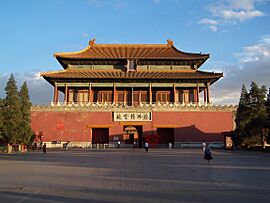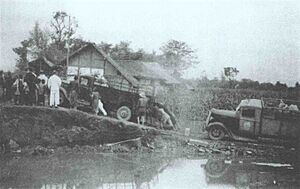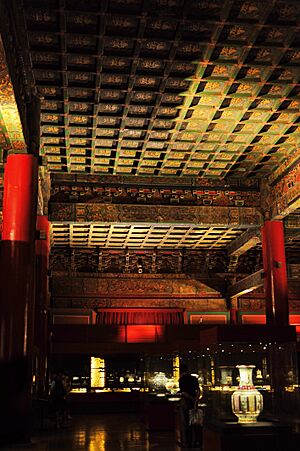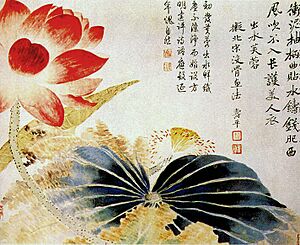Palace Museum facts for kids
| 故宫博物院 | |||||||||||
 |
|||||||||||

Front view of the Museum
|
|||||||||||
| Established | 10 October 1925 | ||||||||||
|---|---|---|---|---|---|---|---|---|---|---|---|
| Location | Forbidden City 4 Jingshan Front St, Dongcheng, Beijing |
||||||||||
| Type |
|
||||||||||
| Collection size | 1,860,000 | ||||||||||
| Visitors | 17 million (2018) | ||||||||||
| Public transit access | 1 at Tian'anmendong 2 8 at Qianmen |
||||||||||
| Built | 1406–1420 | ||||||||||
| Architect | Kuai Xiang | ||||||||||
| Architectural style(s) | Chinese architecture | ||||||||||
| Chinese name | |||||||||||
| Chinese | 故宫博物院 | ||||||||||
| Literal meaning | Former-Palace Museum | ||||||||||
|
|||||||||||
The Palace Museum (Chinese: 故宫博物院; pinyin: Gùgōng Bówùyùan), also known as the Beijing Palace Museum, is a huge national museum located inside the famous Forbidden City in Beijing, China. It covers a massive area of about 720,000 square meters (178 acres). The museum opened in 1925. It was created in the former imperial palaces of the Ming and Qing emperors. The last emperor, Puyi, had moved out in 1924.
The Forbidden City, where the museum is located, was built between 1406 and 1420. The museum has 980 buildings and is home to over 1.8 million pieces of art. Most of these artworks came from the imperial collections of the Ming and Qing dynasties. Over the years, the museum's collection has grown with new items, transfers from other museums, and exciting archaeological finds.
The Palace Museum is one of the most visited museums in the world. In 2018, it welcomed over 17 million visitors. To protect the old buildings and make sure everyone has a good experience, the museum limits visitors to 80,000 per day since 2015.
Contents
History of the Palace Museum
The Forbidden City Palace
The Palace Museum is located within the Forbidden City. This was the Chinese imperial palace from the Ming dynasty until the end of the Qing dynasty. It stands in the center of Beijing, China. For nearly 500 years, it was the home of the emperor and his family. It was also the main place for ceremonies and government in China.
The Forbidden City was built from 1406 to 1420. It has 980 buildings that are still standing, with 8,707 rooms. The entire complex covers about 720,000 square meters. The palace shows off traditional Chinese palace architecture. It has influenced building styles and culture across East Asia and beyond. In 1987, the Forbidden City became a World Heritage Site. UNESCO lists it as the largest collection of old wooden buildings in the world that are still preserved.
Becoming a Museum

In 1912, Puyi, the last emperor of China, gave up his throne. He was allowed to stay in the Inner Court of the Forbidden City. The Outer Court was opened to the public, and a small museum was set up there. In 1924, Puyi was asked to leave the Inner Court after a change in government. The Palace Museum then officially opened in the Forbidden City on October 10, 1925.
The museum's collections came from the Qing imperial family. An audit in 1925 found about 1.17 million art pieces in the Forbidden City. The imperial libraries also held many rare books and historical documents.
In 1933, there was a threat of Japanese invasion. Because of this, the most important parts of the museum's collection were moved to safety. After World War II ended, these collections were returned to Nanjing. However, during the Chinese Civil War, the Nationalist government decided to move the best parts of the collection to Taiwan. Out of 13,491 boxes of artifacts, 2,972 boxes are now at the National Palace Museum in Taipei. This collection forms the main part of that museum. More than 8,000 boxes were returned to Beijing. About 2,221 boxes are still stored at the Nanjing Museum.
After the People's Republic of China was formed, the museum did a new check of its collections. They found many important items. The government also moved items from other museums to the Palace Museum. They also bought new pieces and received donations from people.
Museum Collections
Today, the Palace Museum has over a million rare and valuable artworks in its permanent collection. These include paintings, ceramics, seals, sculptures, bronze items, and more. The collections are based on what the Qing imperial family owned.

An inventory from 2004 to 2010 showed that the museum holds 1,807,558 artifacts. Of these, 1,684,490 are considered "valuable cultural relics." By the end of 2016, the museum announced that 55,132 new items had been found during a check from 2014 to 2016. This means the total number of items in the Palace Museum collection is now 1,862,690 objects.
Ceramics Collection
The Palace Museum has 340,000 pieces of ceramics and porcelain. This includes imperial collections from the Tang and Song dynasties. It also has pieces made specifically for the palace or even for the emperor. This collection is very special because it came from the imperial family. It shows the best porcelain made in China. Other large collections are in the National Palace Museum in Taipei and the Nanjing Museum.
The ceramic collection at the Palace Museum tells the story of Chinese ceramic making over the past 8,000 years. It is one of the largest collections of its kind in the world.
Painting Collection
The Palace Museum has nearly 50,000 paintings. More than 400 of these are from before the Yuan dynasty (1271–1368). This is the largest collection of its kind in China. It includes some of the rarest and most valuable paintings in Chinese history.
The collection started with the palace paintings from the Ming and Qing dynasties. Emperors like Qianlong loved art, which helped create one of the most important painting collections in Chinese history. However, some of this collection was lost over time. After he gave up his throne, Puyi moved some paintings out of the palace. Many of these were later lost or destroyed. In 1948, some of the best paintings were moved to Taiwan. Since then, the collection has grown again through donations, purchases, and transfers from other museums.
Jade Collection
Jade is very important in Chinese culture. The museum's collection has about 30,000 jade pieces. Most of these came from the imperial collection. The oldest pieces are from the Neolithic period. The collection also includes famous pieces from history and items found in recent archaeological digs. Jade items from the Ming and Qing dynasties include things used in the palace and gifts from across the empire.
Bronzeware Collection
Bronze is also very important in Chinese culture. It was always a key part of state ceremonies. The Palace Museum's bronze collection dates back to the early Shang dynasty. Out of nearly 10,000 pieces, about 1,600 have writings on them from before the Qin period (before 221 BC). A big part of the collection is ceremonial bronze items from the imperial court. This includes full sets of musical instruments used by the imperial orchestras.
Timepiece Collection
The Palace Museum has one of the world's largest collections of mechanical timepieces from the 18th and 19th centuries. It has over 1,000 pieces. The collection includes both Chinese-made and foreign-made clocks and watches. Chinese pieces came from the palace's own workshops, Guangzhou, and Suzhou. Foreign pieces came from countries like Britain, France, Switzerland, the United States, and Japan. Most of the foreign pieces are from Britain.
One amazing piece in the collection is a clock with a small robot. This robot can write a lucky saying in perfect Chinese calligraphy on a piece of paper.
Palace Artifacts
Besides artworks, a large part of the museum's collection includes items from the imperial court. These are things used by the imperial family and the palace in their daily lives. It also includes items used for ceremonies and government work. This huge collection helps us understand the daily life and traditions of the imperial era.
Exhibitions to See
The museum has two main types of exhibitions. One type is "as-was" exhibitions (Chinese: 原状陈列). These show the rooms just as they looked during imperial times. The other type is "themed exhibitions" (Chinese: 专馆). There are eleven special themed exhibition halls:
- Digital
- Painting & Calligraphy
- Ceramic
- Treasury
- Timepiece
- Sculpture
- Architecture
- Bronzeware
- Xiqu
- Arsenal
- Furniture
Museum Research and Conservation
The Palace Museum has several groups that focus on academics and research. The main ones are the Palace Academy and the Palace Research Institute. They also host the Forbidden City Society and the Society of the Qing Palatial History. There is also a special lab for studying and preserving ancient ceramics.
Research Efforts
The Palace Research Institute is led by Zheng Xinmiao. It publishes the Palace Museum Journal (故宫博物院院刊) and the Journal of Gugong Studies (故宫学刊). It also has many research labs.
Caring for Artifacts
The Hospital for Conservation is the part of the museum that takes care of the artifacts. They are responsible for keeping the items in good condition and restoring them. It has several labs and studios that research and restore different types of artifacts.
Museum Leadership
The current director of the museum is Wang Xudong. He used to be the director of the Dunhuang Research Academy. His predecessor, Shan Jixiang, was well-known for making many improvements to the museum.
Other Palace Museums
The Palace Museum has connections to other museums:
- Kulangsu Gallery of Foreign Artifacts from the Palace Museum Collection in Kulangsu, Xiamen.
- A Northern Branch of the Palace Museum is being built in Xibeiwang, Haidian, Beijing. Construction started in December 2022.
- The Hong Kong Palace Museum in Hong Kong opened in July 2022.
- The National Palace Museum in Taipei, Taiwan, shares the same history but became a separate museum after the Chinese Civil War.
Performances at the Forbidden City
The Forbidden City has also been used for live performances. However, this is very limited because the equipment and performances can affect the old buildings. Most performances said to be "in the Forbidden City" actually happen just outside the palace walls.
- In 1997, the composer and keyboardist Yanni performed a live concert there. He was the first modern Western artist to perform at this historic Chinese site. The concert was recorded and later released as part of his Tribute album.
- In 1998, Giacomo Puccini's opera, Turandot, which is about a Chinese princess, was performed at the Imperial Shrine just outside the Forbidden City for the first time.
- In 2001, the Three Tenors, Plácido Domingo, José Carreras, and Luciano Pavarotti, sang in front of the Forbidden City's main gate.
- In 2004, the French musician Jean Michel Jarre performed a live concert there. He was joined by 260 musicians as part of the "Year of France in China" celebrations.






